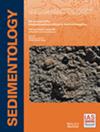与巴塔哥尼亚冰川-火山相互作用有关的上层流态沉积:南安第斯地区更新世记录的启示
IF 2.8
2区 地球科学
Q1 GEOLOGY
引用次数: 0
摘要
超临界流及其相关的上流变床形在世界各地一些对比强烈的沉积环境(包括火山沉积环境)中得到了越来越多的认可。近年来,在与冰川-火山相互作用有关的上层流-机制床形态的流动建模、结构和沉积动力学方面取得了重大进展,但这些研究大多来自特定的火山地貌。我们需要其他地区不同构造和火山环境的实例,以获得有关上-流-火山作用冰川-火山岩床形成和保存的更全面的视角。本研究详细分析了南火山区南安第斯山脉冲积至湖泊三角洲环境中积累的更新世火山碎屑沉积物。通过研究沉积特征,包括纹理特征、沉积结构、构造和成分,确定了六个面,并将其与独特的床形联系起来。在这些岩层面中,有五个岩层面是由超临界流沉积和上层流时期的岩床形态(如循环台阶、槽和池以及反沙丘)区分开来的。地层演替显示,反复出现的超临界流占主导地位,这似乎是受可清除的碎屑以及突发性水流的影响。成分分析表明,火山爆发是碎屑的主要来源,与沉积作用同步进行。此外,该地区广泛出现的更新世冰川条件表明,火山引起的冰雪融化可能是重要的供水来源。关于南安第斯山脉,当地洼地(如火山构造破火山口)的存在在生成和保存与冰川-火山作用有关的上层流态床形方面起着至关重要的作用。此外,进行详细的多学科研究似乎对在安第斯山脉的记录中确认这些沉积物至关重要。本文章由计算机程序翻译,如有差异,请以英文原文为准。
Upper‐flow‐regime deposits related to glacio‐volcanic interactions in Patagonia: Insights from the Pleistocene record in Southern Andes
Supercritical flows and their associated upper‐flow‐regime bedforms have been increasingly recognized in several contrasting depositional environments around the world, including volcano‐sedimentary settings. In recent years, there have been significant advances in flow modelling, architecture and depositional dynamics in upper‐flow‐regime bedforms related to glacio‐volcanic interaction, however most of these works come from specific volcanic landscapes. Examples of other regions with different tectonic and volcanic settings are needed in order to gain a more global perspective regarding the generation and preservation of upper‐flow‐regime glacio‐volcanic bedforms. This study presents a detailed analysis of Pleistocene volcaniclastic deposits accumulated in alluvial to lacustrine deltaic environments in the Southern Andes within the Southern Volcanic Zone. Six facies were defined and related to distinctive bedforms by examining sedimentary features, including textural characteristics, sedimentary structures, architecture and composition. Among these facies, five are distinguished by deposition from supercritical flows and upper‐flow‐regime bedforms, such as cyclic steps, chutes and pools, and antidunes. The stratigraphic succession reveals a predominance of repeated supercritical flows, which appear to be influenced by the availability of detritus for removal along with sudden water discharges. Compositional analyses indicate that explosive volcanism was the primary source of detritus, occurring synchronously with sedimentation. Additionally, the widespread occurrence of Pleistocene glacial conditions in this region suggests that volcanic‐induced melting ice or snow may have been an important source of water supply. Regarding the Southern Andes, the presence of local depressions, such as volcano‐tectonic calderas plays an essential role in the generation and preservation of the upper‐flow‐regime bedforms related to glacio‐volcanism. Furthermore, the importance of carrying out detailed and multidisciplinary studies seems to be critical for the recognition of these deposits in the record of the Andes.
求助全文
通过发布文献求助,成功后即可免费获取论文全文。
去求助
来源期刊

Sedimentology
地学-地质学
CiteScore
8.20
自引率
11.40%
发文量
94
审稿时长
6-12 weeks
期刊介绍:
The international leader in its field, Sedimentology publishes ground-breaking research from across the spectrum of sedimentology, sedimentary geology and sedimentary geochemistry.
Areas covered include: experimental and theoretical grain transport; sediment fluxes; modern and ancient sedimentary environments; sequence stratigraphy sediment-organism interaction; palaeosoils; diagenesis; stable isotope geochemistry; environmental sedimentology
 求助内容:
求助内容: 应助结果提醒方式:
应助结果提醒方式:


